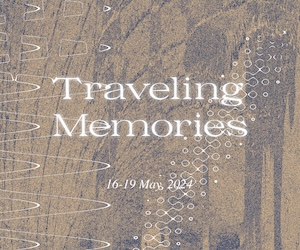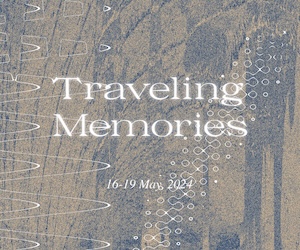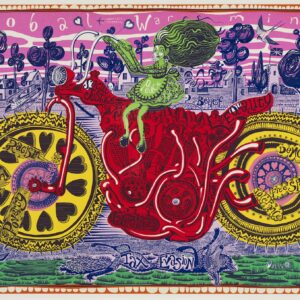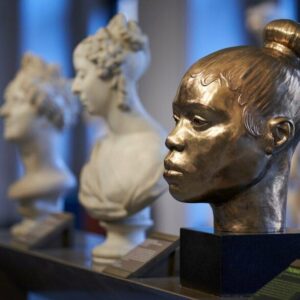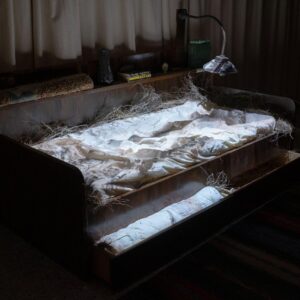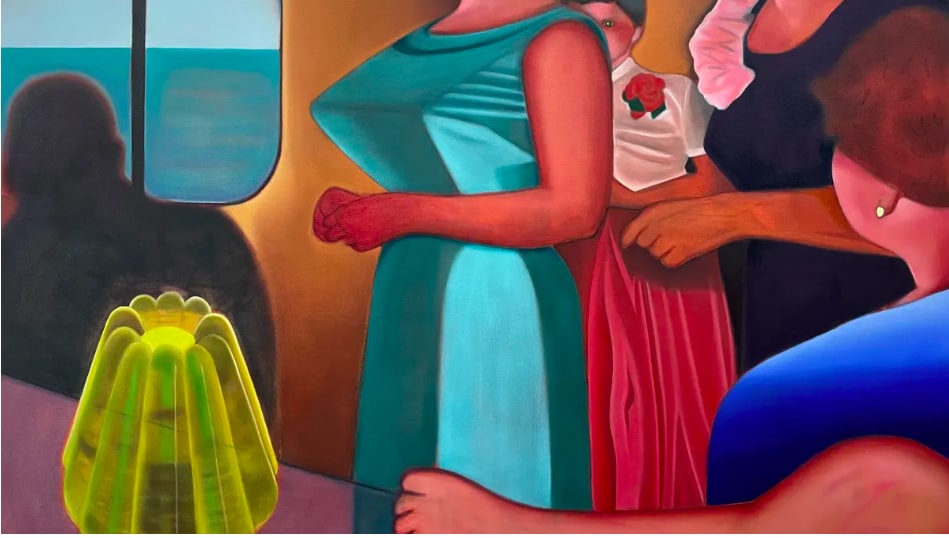
In 1936 the RMS Queen Mary, Cunard’s great Blue Riband transatlantic ocean liner, first sailed. After 31 years of active sailing, she was moored in Long Beach, California, where she remains, her condition in slow decline. She is there a mark of something all too present as that which is gone, a lost time, a dream that condenses and reconfigures the great measures of libidinal force organised there in images and stories of a life all at sea.
It was only two years after the launch of Queen Mary that Marine Court opened, an extraordinary paean to the Queen Mary, a sumptuous deco land liner – an apartment building in the style of the great ship. And it too has served those who reside therein, and a redolent imaginarium of rich excesses of enjoyments past, but unlike the Queen Mary, the decline of the great Marine Court has been halted, halted and reversed, and so Peter von Kant finds itself there a home, a port, a place between, between the island and the sea, for a start.
A Freeport is a kind of space between, of course, a place known to the artworld as a dry financial tool, a place where art can be held without entering customs zones that would require payments. The payment is made rather in the form of the artwork being rendered invisible, and the freeport becomes a sort of repository of potentialities, of the potential that all that art might hold – the financial value remains experientially abstract, but all that the experience of the art may provide is held in waiting, hidden, stored, like in a battery – if a battery holds potential energy, and a freeport is there to hold a financial energetics, then there is a side effect, that if pierced, some kinds of battery may produce a great and sudden amount of heat, explosive even – an energetics for which the battery was not designed. So the battery of financial capital is there, waiting, on the one hand, to be realised as a commodity value, and on the other, a potential for the heat of experience that art may offer.
For her show at Peter von Kant in Marine Court, Sally Kindberg has made a series of new paintings drawing their thematic resources from images of the golden age of the Queen Mary.
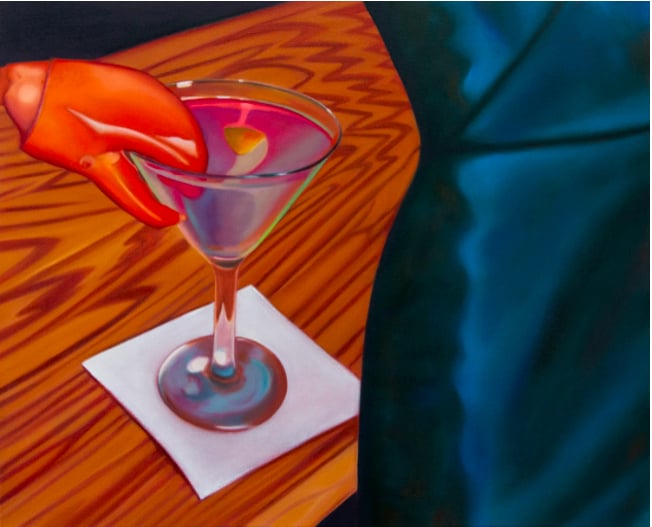
Sally loves word play, jokes, wit, and her paintings are filled with wit, as one signifier slides towards the next. In ‘Club Horizon’ a toxically incandescent jelly floats on a counter in counterpoint to the horizontal bust of a woman dressed in a sea-green satin that carries waves not seen in the sea through the window. Her hands are red as if raw, a woman behind her holds something made of red fabric which seems not without allusion to female sexual organs, and a boy, perhaps a boy, wears a red rose, whilst the woman holding the fabric bares a phallic pink corsage. The corners of the painting fold around different elements making of the painting a porthole through which the viewer is both rendered into the scene and kept at a distance therein. The people in the scene all have faces cut off, hidden, turned away, or in shadow. High glamour on open seas steams towards the vulgar pleasures of the saucy seaside postcard. Carry-On moves towards The Shining.
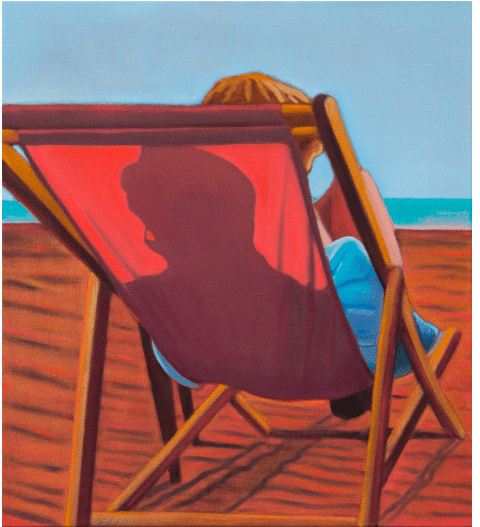
The philosopher and mathematician Gottlob Frege, in trying to conceptualise language, arrived at a distinction between sense, or meaning (which he called Sinn), and denotation or reference (which he called Bedeutung), separating out these terms allows a disturbance of a common sense idea that the meaning of an expression constitutes a captation of its reference, the meaning of cat refers to a certain class of mammal, there is an idea that the truth of a question couched in meaning can be determined in relation to its reference – we can say that this creature is a cat by virtue of a relation of meaning and reference. But of course we can see that a unicorn is a thing of pure meaning, insofar as there is no such creature as that to which the term refers, there is a kind of nonsense of the unicorn – a nonsense because it is sense without reference, and as such in a way the high point of sense, unsullied by a close tie to that which is not sense – reference. The world of Sally’s paintings have their reference in the sense that she draws on popular imagery, in found sources, but a disjunction of meaning and reference in the all at sea, by which signifiers slip freely here and there. Her painting ‘Freeport’ shows an old telephone of the sort found in every cabin on the Queen Mary. There is no dial by which a call may be directed, and in the centre of where the dial would be is no further point of reference than the infinite of a horizon of sea and open sky. The mouthpiece morphs into a shell, the point from which the sweet nothings whispered by the sea may be heard becomes a receptacle for the voice. The phone hovers a little, and wallpaper, its pattern pointing down, wraps around in a disjointed and slightly threatening proximity. The scale of the painting, a fair bit larger than a phone, lends a presence which further disrupts the safe passivity obtained by the feeling that sense and reference fit neatly together.
But Sally’s paintings are not quite like unicorns. They are not little games of the sensicality of nonsense. Rather they have a bit of the bite of a different order of reference. In ‘Blue Claw’ an indeterminate cocktail sits atop a napkin on a wooden counter, inflected with strange colours of light, a slice of lemon in the drink is supplemented by a disjointed lobster claw which grasps the glass. One side of the canvas is cut by another satin blue dress come sea turned sideways, the woodgrain on the counter is a bit too alive, and its spiky pattern attacks the dress. The inanimate world is rendered startlingly animate, in fact almost a bit too alive, and the lively, the witty, the light, can take on a threatening underside. This excess of life which occupies Sally’s paintings, a libidinal excess if you like, is a liveliness of the drive not itself representable. It animates the shifting abundance of sense set loose, but is itself not the stuff of meaning, of sense. This seems to be the reference proper to Sally’s work, the horizon by which the work is oriented, to which the work gives a home. If there is a kind of amazing nonsense in these paintings, it is the nonsense of a reference flooding the scene which is itself not at all a thing of sense, of meaning, and which overflows from the signifiers at play. In ‘Under the Sea’ the wrought mound of a green jelly is surrounded by, perhaps cakes, which are also half eggs, a candle burns stiff and upright enveloped at its base by the blue splash of its candle stick – which also seems to melt a little up the candle. In ‘Room Service (No.40. ACID EGGS)’, the eggs are there again, a red jelly now the centrepiece of a strange salad, it’s not quite certain what one consumes in this mixed dish of signifiers. In ‘Tango’ two candles entwine with amorous intent.
The handling of paint in Sally’s paintings shifts and moves in a lively manner – a scrubbed mark here in which the application is emphatic, gives way freely to bits of thicker paint where the material applied is more present, design ever on the edge of giving way to the ever contingent enjoyment of its production. A kind of enjoyment which tends to the horizon of the limitless is given a certain frame here. Perhaps the capacity of art, occasionally, to frame what is a bit limitless of life, to reserve a bit of the too much of life can be a kind of freeport, if you like. Not so much the freeport which contains a financial value at the expense of the life of art, but a freeport which frames the horizon of libidinal excess, a possibility of a mediation of reference with sense, which allows for an extraordinary play – vivid, joyful, funny, dark, and difficult, to find its mark. Alasdair Duncan, 2021
PvK-on-Sea . St Leonards-on-Sea Drinks reception Saturday 26th June 2021, 4–8 pm by guest list only / RSVP mail@petervonkant.com if you wish to attend. Then through 28th August by appointment only petervonkant.com
